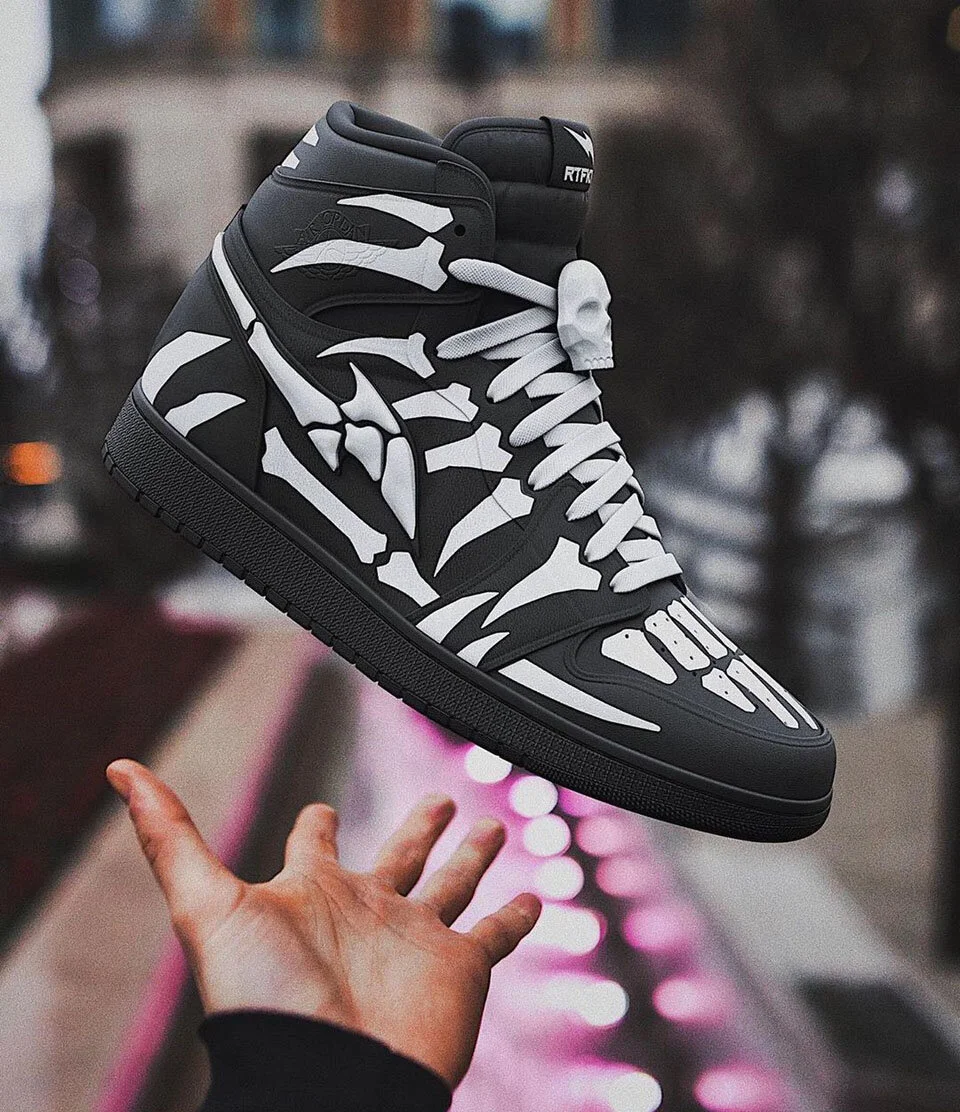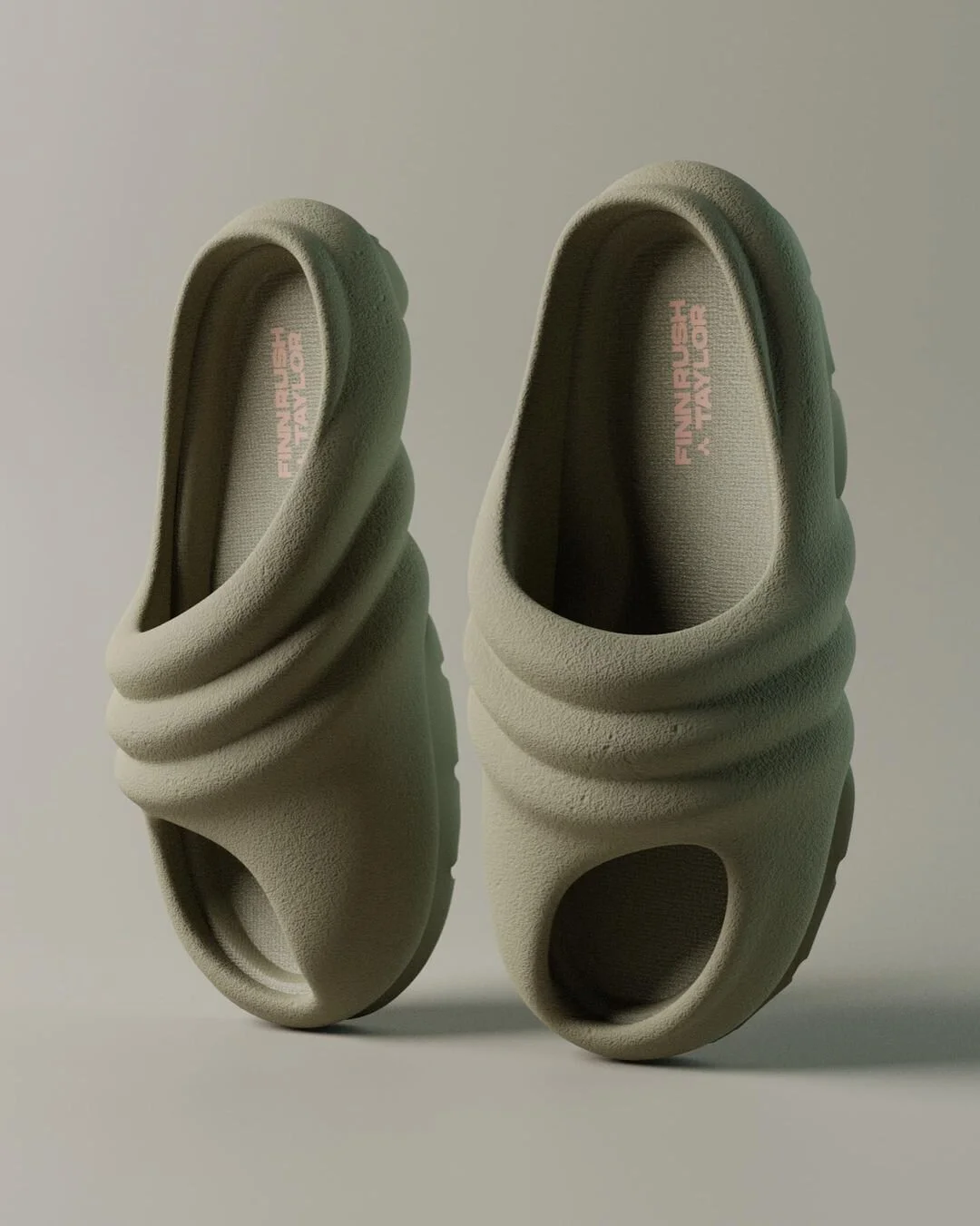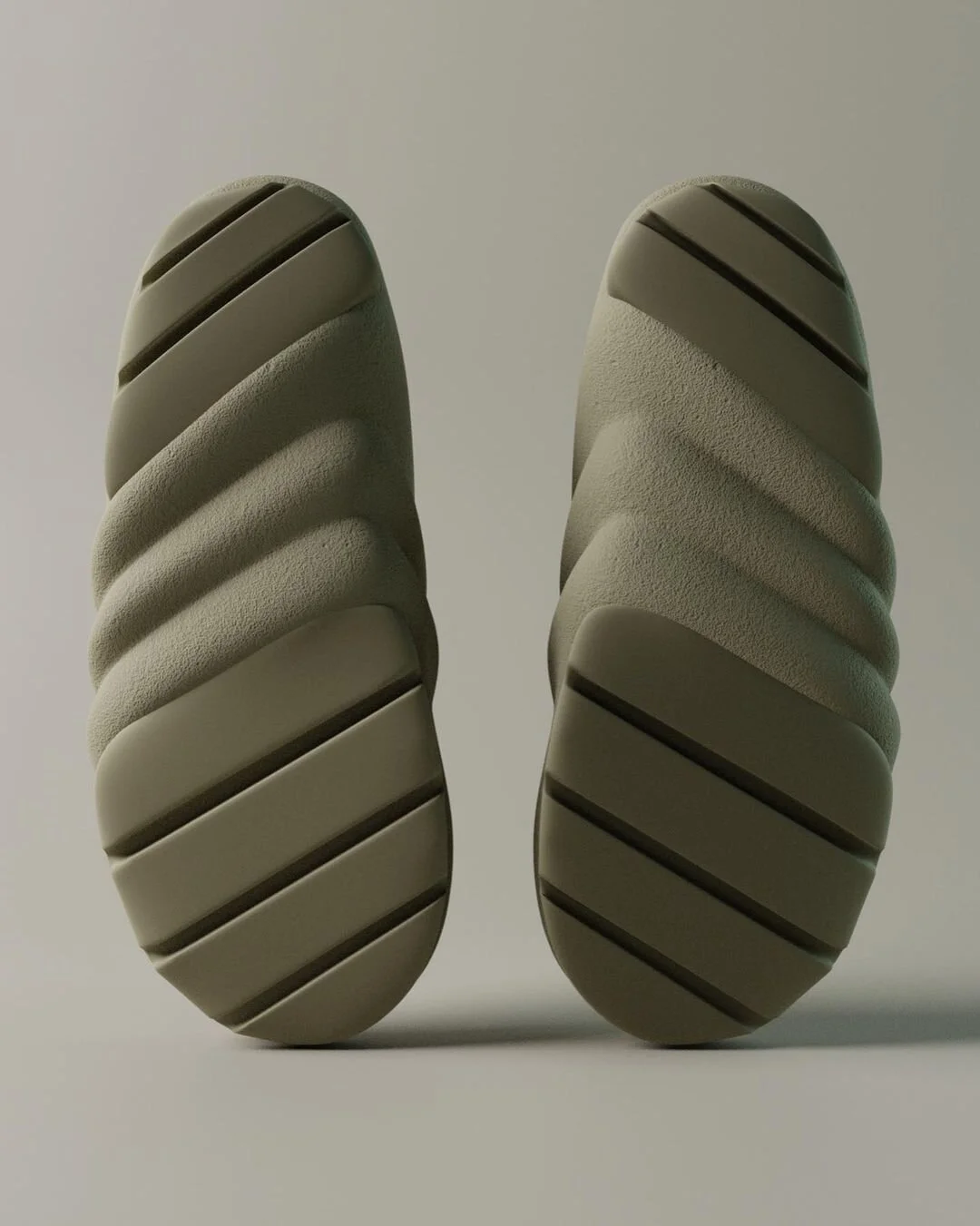Mind Your Step 003: Sustainability
Dogecoin, Litecoin and Ripple’s XRP sound like codenames to some and currency to others. As the world of cryptocurrency continues to fluctuate, with market busts and booms happening more often than turns around the sun, one thing that remains steady is the footwear industry’s ignited interest in NFTs. As we continue our exploration of planet-friendly footwear futures, otherworldly digital non-fungible tokens are entering the fold. But are NFTs really the industry’s sustainable solution?
“I think that a lot of people in the footwear industry are looking at NFTs and wondering where the value is, and I’m not too sure either,” admits Finn Rush-Taylor, architect of his own eponymous VR and Digi-led footwear design studio and concept-maker at Adidas. He’s not alone, as the hype around non-fungible tokens, blockchain and Ethereum bubbles behind closed studio doors of industry greats, the majority of sneakerheads are left bewildered when trying to understand digital assets.
So, we did the leg work and got in touch with the people at the forefront of the non-fungible token, crypto-fashion race.
NFTs are a one-of-a-kind digital asset that is minted into blockchain technology. Unlike cryptocurrencies like bitcoin, the creative outputs - that have usually taken shape as pieces of art - are entirely unique. Instead of fungible digital assets that all mirror one another and are forever interchangeable, NFTs run in editions and may look identical to the naked eye but are metaphorically a digital snowflake on the chains where they reside.
Based on a strategy of editions, transparency, and limited production, it’s no wonder that the art world assimilated NFTs before their fashion colleagues. In fact, it’s agreed by crypto-heads that early meme creators were the first to move tokens away from coins and into creative culture. In 2016, Rare Pepes started to be traded on Counterparty and later on Ethereum, two of the earlier decentralised, peer-to-peer cryptocurrency exchange applications.
Fig.1 RTFKT Studio Bone Trooper & Cyber Sneaker
“Beeple is a poster child for the whole movement,” explains Steven Zaptio, one of the founders of the prolific virtual sneaker studio, RTFKT. Mike Winkelmann, aka Beeple, is a graphic designer who posted a digital image online every day for 14 years. He hurtled NFTs into the spotlight when the non-fungible token .jpeg collage of these daily images Everydays: First 5000 Days sold for over $69 million at renowned auction house Christie's last month. This makes Beeple one of the top three most valuable living artists.
Speaking of poster children, Steven Zaptio, Benoit Pagotto and Chris Le sit at the forefront of footwear NFT creation. Merging backgrounds in streetwear and gamification, they founded RTFKT studio on an intuition: “We all had a vision of gaming and fashion merging. Streamers started to wear hype clothes and we thought that in the future, it's going to all merge. So we created RTFKT and started selling collectable shoes, clothes and accessories that can be gamified and authenticated on the blockchain.”
The trio’s first foray into NFTs relied on Bitcoin’s frontman Elon Musk. Last year, the studio edited a pair of Cybertruck-inspired, Nike swoosh-inclusive shoes onto a picture of the Tesla founder at the Met Gala in 2018. This hurtled them to the forefront of digital footwear and gave them the fast forward they needed to bring digital futures into the now.
“The studio made use of the unlimited possibilities of the digital to collaborate with 18-year-old artist Fewocious on a drop of three pairs of sneakers. Those who won the accumulative $3.1 million bid became owners of both NFTs and tangible sneakers. Although this bridge between the digital and the physical brought the masses to the blockchain auction, Zapito makes it clear: “When people buy a product from us they're paying for the NFT, the physical is just an extra collector's item.”
Fig.2 Dissrup by Yambo Studio
We can’t get away from the fact that our digital worlds are transgressing. With no one raising eyebrows as Tik Tok dances hit newly open outdoor dance floors and Gen Zs spend more money on their Fortnite skins than their IRL get-ups, it makes sense that these fashion items are gaining traction for gamification and AR filters. But how can this technology sustain a very tangible footwear design industry?
“We feel like there is big potential in selling products that have both a physical and digital existence,” explains Yam Ben Adiva, founder of CGI-driven global design studio Yambo, who is currently working on creating the NFT-based ‘phygital’ brand Dissrup with both Zellerfeld and Finn Rush-Taylor.
Yam continues: “We are thinking about scalability and affordable prices, the idea is that most people will be able to afford a digital token that they will use in their games or on social media and others will pay more for limited amounts of tangible items.”
Harking back to streetwear culture’s limited drop availability, today’s non-fungible tokens are traded on an exclusive basis and revolve around a very tight knit community. But, unlike streetwear, blockchain technology ensures that the tokens that exist in your digital wallet are genuine. Through encryption and fully transparent traceability, the people creating non-fungible token footwear, artwork or even tweets know that they will receive the sale assets that they are entitled to.
“NFTs protect the digital industry and digital makers more than ever before.”
Leanne Elliott Young
Co-founder of the Institute of Digital Fashion
Fig 3. Finn Rush Taylor Bootlegged Series
Earlier this year, Finn Rush Taylor was burnt when online marketplace AliExpress lifted his design concept after it was shared on Yeezy fan accounts, after being copied he turned the slide into an NFT in spite of the rip-off: “They were trying to jump the gun, be smart and reproduce it. I was living off of the hype of it and thought I could turn it into something positive with this new technology.”
The safety of digital makers is heightened two-fold by the copyright that surrounds these futuristic credits. Acting as a virtual blueprint for the item bought, those investing in NFTs do not receive any copyright of the asset, they can only use and display the asset within their metaverse.
“NFTs protect the digital industry and digital makers more than ever before. For a long time, digital work was put into the ether, it could be shared in the social space and adopted. The edition strategy and blockchain authentication make this an extremely powerful move for URL makers,” states Leanne Elliott Young, co-founder of the Institute of Digital Fashion, the world’s top digital fashion fabrication studio.
As well as sustaining healthy industry transactions, the original NFT community is driven to provide the next generation of digital makers equal and accessible opportunities. Aware that they are working in an expensive digital realm, IoDF provides training at both Parsons and University of the Arts London in areas of digital fashion, as well as having a philanthropic arm of support to the business too. RTFKT is also dedicated to collaborating with everyone equally: “We only work on 50/50 royalty splits, we think that artists, creators and brands should have a better arrangement that provides safety against contract and royalty issues.”
These healthy industry transactions can only occur when they have foundations in free, top-level, innovative footwear concept design. One NFT footwear trailblazer who uses the Metaverse to harness his creative outlet is Boston-based GravitySketch-pro Joey Khamis who creates his concepts and NFTs using virtual reality headsets. Through harnessing new technology, Khamis can design without limits: “This new medium is super intuitive and has been amazing for creativity. It allows you to take these concepts that make no sense in the world and place them into a marketplace that is accepting of fantasy concepts.”
So far, NFTs feel like the way forward for futuristic, sustainable footwear. However, until now, the planet that we walk upon has been neglected in this packaging, delivery and consumption free crypto-universe.
It is undeniably difficult to calculate the carbon footprint of NFTs solely as they stand for such a small portion of the Ethereum platform. However, a single Ethereum transaction currently consumes 76.23 kWh of electrical energy, which is equal to the power consumption of an average US household over two and a half days, and has a carbon footprint of over 36 kg CO2. As Ethereum mining is set to triple and interest in NFTs continues to grow, it’s obvious that more eco-conscious practices must be implemented if the footwear industry wishes to nurture a healthy planet.
Fig. 5 Bubbles concept by Joey Khamis
Although Ethereum mining is more planet-friendly than its counterparts, it still runs on a traditional Proof of Work system: “By the process of trial and error, miners try to guess the winning number to make the next block for the blockchain. So, they have all of their machines running in the background entering the lottery quintillions of times per second whilst Ethereum transactions sit at 17 per second. This is extremely disproportionate," explains Alex de Vries, founder of the sustainable cryptocurrency-focused publication Digiconomist and builder of the Bitcoin Energy Consumption Index.
“Moving to proof of stake instead of proof of work would reduce Ethereum’s carbon and electrical consumption by 99.99%,” he continues. A Proof of Work transaction is solely reliant on the amount of cryptocurrency wealth that miners hold. This means that they can use whichever device they already own, as it eliminates the need for specialised equipment and computational power.
Ethereum has been trying to make this shift between ways of working for the last three years, and despite their aim to switch in 2021, de Vries predicts it won’t occur until 2022 as the platform gains popularity exponentially and increased trading takes place.
Fig. 6 ImpactScope Crypto Offset Tools
Until then, social enterprises like ImpactScope are working with miners to provide them with the tools they need to offset their carbon emissions and encourage mining on gas free Layer-2 solutions. By creating a second ‘layer’ on top of existing blockchains, people can trade and streamline the result of their transaction, reintroduce it to the original blockchain, thus a reduced number of transactions have to be verified by a ledger. This consumes less electrical energy, reduces carbon footprint, and stops the chains from clogging.
So, as the creative fashion industry, social enterprises, NFT minters and Ethereum miners continue to work together on the creation of more sustainable NFTs, there's no doubt that we'll be flexing our digital wardrobe to our followers more than we will our tangible ones to our work colleagues.
This shift feels like the start of a fashion revolution: “In 10 years, we’ll be laughing about this conversation and making post-metaverse memes about how our first digital items were so expensive and exhaustive,” concludes Leanne Elliott Young, proving that the digital tokens that found their feet in memes will predictably come full circle.








